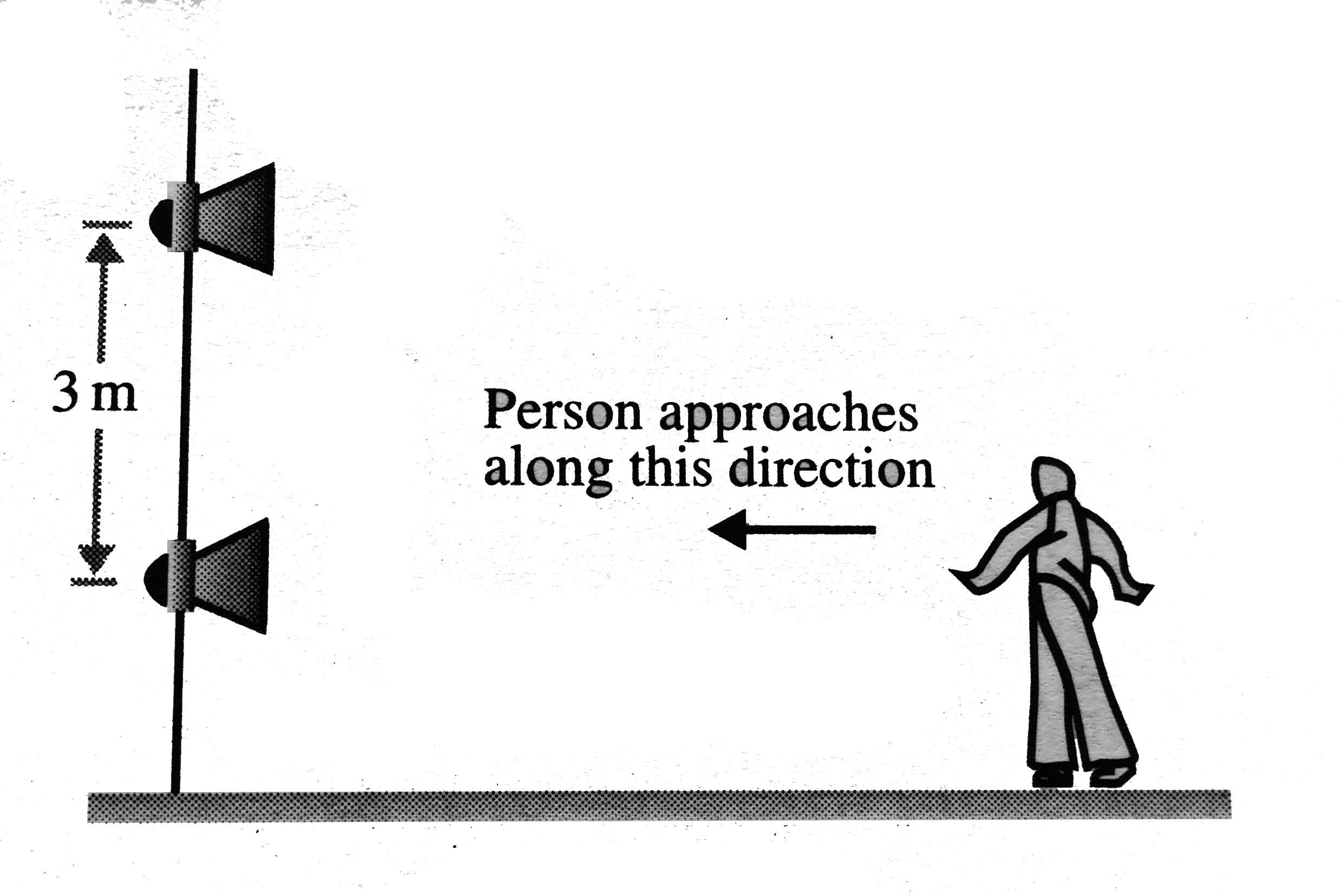If the sound waves produced by the tuning fork can be expressed as y=0.2(cm)sin(kx−ωt) , where K=2π/λ and ω=2πf(f=512Hz), maximum value of amplitude in a beat will be
0.4cm
0.6cm
0.8cm
0.2cm
The correct Answer is:A
To solve the problem step by step, we will analyze the given wave equation and determine the maximum amplitude of the beats produced by the superposition of two sound waves.
Step 1: Understand the wave equation
The wave produced by the tuning fork is given by:
y=0.2cmsin(kx−ωt)
Here, 0.2cm is the amplitude of the wave.
Step 2: Identify the amplitude of the wave
The amplitude of the wave is the coefficient in front of the sine function. Therefore, the amplitude A of the sound wave is:
A=0.2cm
Step 3: Determine the nature of beats
When two waves of slightly different frequencies interfere, they produce a phenomenon called beats. The amplitude of the resulting wave can vary between the sum and the difference of the individual amplitudes.
Step 4: Calculate the maximum amplitude of the beats
If two waves with the same amplitude A interfere, the maximum amplitude of the resulting wave (the beat) can be calculated as:
Amax=A1+A2
Since both waves have the same amplitude A=0.2cm:
Amax=0.2cm+0.2cm=0.4cm
Step 5: Conclusion
Thus, the maximum value of the amplitude in a beat will be:
Maximum Amplitude=0.4cm
Final Answer
The maximum value of amplitude in a beat will be 0.4 cm.
---
The wave produced by the tuning fork is given by:
y=0.2cmsin(kx−ωt)
Here, 0.2cm is the amplitude of the wave.
The amplitude of the wave is the coefficient in front of the sine function. Therefore, the amplitude A of the sound wave is:
A=0.2cm
When two waves of slightly different frequencies interfere, they produce a phenomenon called beats. The amplitude of the resulting wave can vary between the sum and the difference of the individual amplitudes.
If two waves with the same amplitude A interfere, the maximum amplitude of the resulting wave (the beat) can be calculated as:
Amax=A1+A2
Since both waves have the same amplitude A=0.2cm:
Amax=0.2cm+0.2cm=0.4cm
Thus, the maximum value of the amplitude in a beat will be:
Maximum Amplitude=0.4cm
The maximum value of amplitude in a beat will be 0.4 cm.
Topper's Solved these Questions
- SUPERPOSITION AND STANDING WAVESBOOK - CENGAGE PHYSICS ENGLISHCHAPTER - SUPERPOSITION AND STANDING WAVESEXERCISE - Multiple
26 Videos
- SUPERPOSITION AND STANDING WAVESBOOK - CENGAGE PHYSICS ENGLISHCHAPTER - SUPERPOSITION AND STANDING WAVESEXERCISE - Assertion - Reasoning
6 Videos
- SUPERPOSITION AND STANDING WAVESBOOK - CENGAGE PHYSICS ENGLISHCHAPTER - SUPERPOSITION AND STANDING WAVESEXERCISE - Subjective
24 Videos
- SOUND WAVES AND DOPPLER EFFECTBOOK - CENGAGE PHYSICS ENGLISHCHAPTER - SOUND WAVES AND DOPPLER EFFECTEXERCISE - Integer
16 Videos
- THERMODYNAMICSBOOK - CENGAGE PHYSICS ENGLISHCHAPTER - THERMODYNAMICSEXERCISE - 24
1 Videos
Similar Questions
An oscillator of frequency 680Hz drives two speakers . The speakers are fixed on a vertical pole at a distance 3m from each other as shown in Fig. 7.103. A person whose height is almost the same as that of the lower speaker walks towards the lower speaker in a direction perpendicular to the pole. Assuming that there is no reflection of sound from the ground and speed of sound is v=340m/s , answer the following questions.

At some instant , when the person is at a distance 4m from the pole , the wave function ( at the person's location) that describes the waves coming from the lower speaker y=Acos(kx−ωt) , where A is the amplitude , ω=2πv with v=680Hz (given) and k=2π/λ
Wave function ( at the person's location) that describes waves coming from the upper speaker can be expressed as :
View SolutionTwo coherent sources emit light waves which superimpose at a point where these can be expressed as
E1=E0sin(ωt+π/4)
E2=2E0sin(ωt−π/4)
Here, E1andE2 are the electric field strenghts of the two waves at the given point.
If I is the intensity of wave expressed by field strenght E1, find the resultant intensity
View Solution
Knowledge Check
The voltage over a cycle varies as
V=V0sinωt for 0≤t≤πω
=−V0sinωt for πω≤t≤2πω
The average value of the voltage one cycle isAV0√2BV02CzeroD2V0π
Two SHM's are represented by y1=Asin(ωt+ϕ),y2=A2[sinωt+√3cosωt]. Find ratio of their amplitudes.
View SolutionFind the resultant amplitude and the phase difference between the resultant wave and the first wave , in the event the following waves interfere at a point , y1=(3cm)sinωt,
y2=(4cm)sin(ωt+π2),y3=(5cm)sin(ωt+π)
View SolutionEquation of motion in the same direction is given by y1=Asin(ωt−kx),y2=Asin(ωt−kx−θ). The amplitude of the medium particle will be
View SolutionFind the average speed of a particle whose velocity is given by V=V0sinωt t where T=2π/ω is the time of complete cycle
View SolutionThe path difference between the two waves
y1=a1sin(ωt−2πxλ)andy(2)=a2cos(ωt−2πxλ+ϕ) is
View SolutionThe path difference between the two waves
y1=a1sin(ωt−2πxλ)andy(2)=a2cos(ωt−2πxλ+ϕ) is
View SolutionThe voltage over a cycle varies as
V=V0sinωt for 0≤t≤πω
=−V0sinωt for πω≤t≤2πω
The average value of the voltage one cycle is
View Solution
